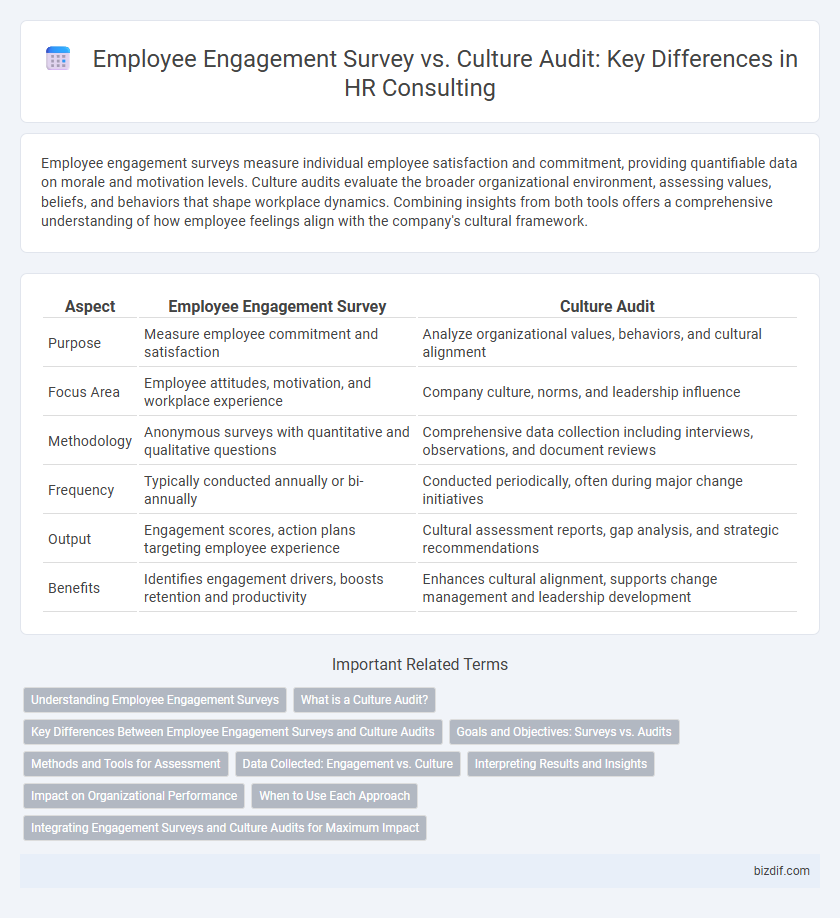Employee engagement surveys measure individual employee satisfaction and commitment, providing quantifiable data on morale and motivation levels. Culture audits evaluate the broader organizational environment, assessing values, beliefs, and behaviors that shape workplace dynamics. Combining insights from both tools offers a comprehensive understanding of how employee feelings align with the company's cultural framework.
Table of Comparison
| Aspect | Employee Engagement Survey | Culture Audit |
|---|---|---|
| Purpose | Measure employee commitment and satisfaction | Analyze organizational values, behaviors, and cultural alignment |
| Focus Area | Employee attitudes, motivation, and workplace experience | Company culture, norms, and leadership influence |
| Methodology | Anonymous surveys with quantitative and qualitative questions | Comprehensive data collection including interviews, observations, and document reviews |
| Frequency | Typically conducted annually or bi-annually | Conducted periodically, often during major change initiatives |
| Output | Engagement scores, action plans targeting employee experience | Cultural assessment reports, gap analysis, and strategic recommendations |
| Benefits | Identifies engagement drivers, boosts retention and productivity | Enhances cultural alignment, supports change management and leadership development |
Understanding Employee Engagement Surveys
Employee Engagement Surveys measure employee satisfaction, motivation, and commitment levels through structured questionnaires targeting specific workplace factors. These surveys provide quantifiable data on employee perceptions, enabling HR consultants to identify strengths and areas needing improvement in organizational engagement. Understanding the nuances of survey design, such as question types and frequency, is essential to accurately capture employee sentiment and drive effective action plans.
What is a Culture Audit?
A culture audit is a comprehensive assessment that examines an organization's core values, behaviors, and workplace environment to identify alignment with strategic goals and employee experiences. Unlike employee engagement surveys that primarily measure employees' feelings and satisfaction, a culture audit delves deeper into organizational norms, communication patterns, and cultural strengths and weaknesses. This analysis provides actionable insights to enhance cultural alignment, improve leadership effectiveness, and drive long-term business performance.
Key Differences Between Employee Engagement Surveys and Culture Audits
Employee Engagement Surveys primarily measure employees' emotional commitment and satisfaction at work, providing quantitative insights into motivation, job satisfaction, and retention risks. Culture Audits take a broader approach by evaluating organizational values, behaviors, and systemic practices through qualitative and quantitative methods to assess alignment between stated culture and actual workplace dynamics. Understanding these key differences helps HR leaders tailor strategies for improving workforce performance and organizational health.
Goals and Objectives: Surveys vs. Audits
Employee engagement surveys primarily aim to measure workforce satisfaction, motivation, and commitment through quantitative data, enabling organizations to identify specific areas needing improvement. In contrast, culture audits focus on qualitative evaluation of organizational values, behaviors, and underlying cultural dynamics to align workplace environment with strategic objectives. Combining insights from both methods supports comprehensive HR strategies that enhance employee experience and drive organizational performance.
Methods and Tools for Assessment
Employee engagement surveys typically use quantitative methods such as Likert-scale questionnaires and pulse surveys to measure employees' emotional commitment and satisfaction levels. Culture audits combine qualitative techniques including focus groups, interviews, and ethnographic observations to assess organizational values, norms, and behaviors comprehensively. Advanced tools like sentiment analysis software and AI-driven data analytics platforms enhance both methods by providing deeper insights and real-time feedback integration.
Data Collected: Engagement vs. Culture
Employee Engagement Surveys primarily collect data on individual satisfaction, motivation, and emotional commitment to the organization, focusing on measurable employee experiences and perceptions. Culture Audits gather comprehensive insights into organizational values, behaviors, and norms, assessing alignment between stated culture and actual workplace practices. Analyzing both engagement and culture data provides a holistic view essential for improving workforce performance and organizational health.
Interpreting Results and Insights
Employee engagement surveys provide quantitative data on workforce motivation, satisfaction, and commitment levels, enabling HR professionals to identify specific areas needing improvement. Culture audits offer qualitative insights into organizational values, behaviors, and underlying cultural dynamics, revealing deeper systemic issues that influence employee experience. Combining both methodologies allows for a comprehensive interpretation of results, facilitating targeted strategies to enhance organizational performance and employee well-being.
Impact on Organizational Performance
Employee engagement surveys measure individual motivation and satisfaction, providing actionable insights to boost productivity and reduce turnover. Culture audits assess organizational values and behaviors, identifying gaps that influence employee alignment and long-term performance. Combining both tools offers a comprehensive approach to enhancing workforce effectiveness and driving sustainable business success.
When to Use Each Approach
Employee Engagement Surveys are ideal for gauging individual employee satisfaction, motivation, and communication effectiveness, especially during periods of organizational change or when seeking to boost morale. Culture Audits provide a comprehensive analysis of organizational values, behaviors, and cultural alignment, making them essential for mergers, leadership transitions, or strategic realignments. Choosing between the two depends on whether the focus is on employee perceptions and engagement levels or understanding and reshaping the core organizational culture.
Integrating Engagement Surveys and Culture Audits for Maximum Impact
Integrating employee engagement surveys with culture audits provides a comprehensive understanding of workforce sentiment and organizational values, enabling targeted strategies that drive productivity and retention. Engagement surveys measure employee satisfaction and motivation levels, while culture audits assess underlying cultural norms and behaviors influencing company dynamics. Combining these tools uncovers alignment gaps and fosters a unified approach to enhancing workplace experience and sustaining organizational health.
Employee Engagement Survey vs Culture Audit Infographic

 bizdif.com
bizdif.com